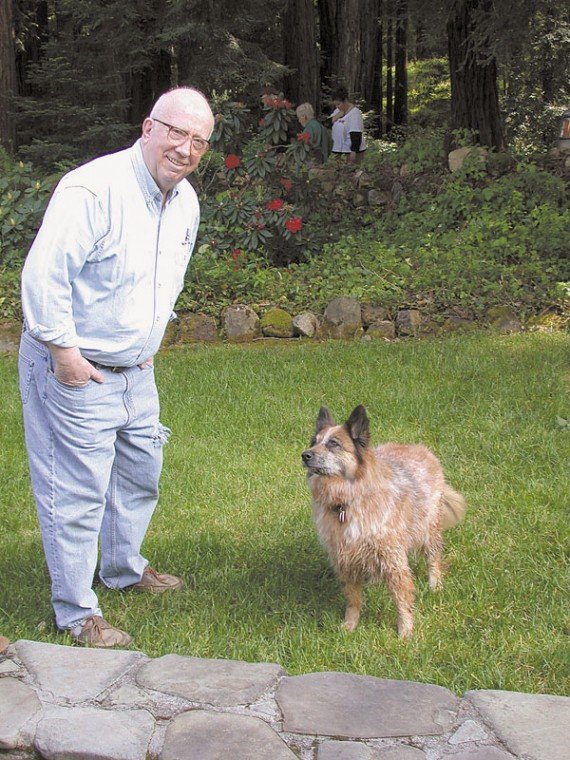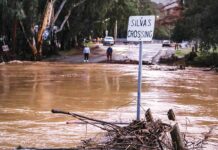Gilroy
– About two dozen local history buffs journeyed to
”
Vanumanutagi
”
to discover South Valley’s fascinating link to
”
Treasure Island,
”
”
Kidnaped
”
and
”
Dr. Jekyll and Mr. Hyde.
”
The bucolic lodge, located at the base of Mt. Madonna along
Redwood Retreat Road, was built at the turn of the century by Fanny
Osborne Stevenson, widow of Robert Louis Stevenson.
Gilroy – About two dozen local history buffs journeyed to “Vanumanutagi” to discover South Valley’s fascinating link to “Treasure Island,” “Kidnaped” and “Dr. Jekyll and Mr. Hyde.”
The bucolic lodge, located at the base of Mt. Madonna along Redwood Retreat Road, was built at the turn of the century by Fanny Osborne Stevenson, widow of Robert Louis Stevenson. The guests listened to a presentation sponsored by the Gilroy Historical Society describing why Mrs. Stevenson made her summer home here in the South Valley.
The event was organized by society members Muriel Brem, Barbara Biafore, Clair McFarland and Roberta Hughan.
About 12 years after the author’s death, Fanny Stevenson purchased 120 acres of foothill land along Redwood Retreat Road west of Gilroy and built an English-style lodge, local historian Elizabeth Barratt told the history enthusiasts. The hilly landscape reminded the woman of the tropical terrain of Samoa where her husband died and was buried in 1894, she said.
“Fanny Stevenson was a widow when she started work on her Redwood Retreat home in 1900,” Barratt told guests as they enjoyed cookies and lemonade on the home’s pool-side deck. “She arrived in the area six years after her husband’s death, intending to establish a home with natural surroundings as a link to the life she had enjoyed with him across the Pacific.”
Stevenson named her home “Vanumanutagi,” which is Samoan for “Vale of the Singing Birds,” Barratt said. As if to accentuate her point, a bird hidden in the nearby redwood trees let out a warble.
How Robert Louis Stevenson’s wife came to South Valley is a story worthy of the great author’s pen. She was born March 10, 1840, in Indianapolis, the oldest of seven children. She was a bit of a “tomboy,” Barratt said.
At 17, she married Samuel Osborne and had three children by him – Belle, Lloyd and Hervey. They lived in various locations including Virginia City, Nev., San Francisco and Oakland.
Samuel was a notorious philanderer, so in 1875 Fanny left him and took the children to Europe. The next year, Hervey died in Paris of tuberculosis. “Grief-stricken, Fanny took the family to Grez near Fontainebleau to recuperate at a hotel frequented by bohemian guests,” Barratt said. “There, via two of his male cousins, she was introduced to another new arrival, Robert Louis Stevenson.”
That afternoon in the Hotel Chevillon in Grez, the author would later admit, Robert fell madly in love “at first sight” with the woman. The pair became lovers. But for unknown reasons, in August of 1878 she returned with her children to Samuel in the United States.
“After her departure, RLS falls despondent,” Barratt said. “Then he hears she has again left her husband and is in Monterey and (she) has sent him an urgent telegram.”
The romantic tale-teller quickly departed for his love on the Devonia, a steamship leaving Glasgow’s port on Aug. 9, 1879. Ten days later, he reached New York City. The next day, he traveled by train to Oakland. There, he traversed San Francisco Bay by ferry and rode the rail to Salinas, where he hopped on a train to Monterey. It took him three weeks to make the 6,000-mile trip to meet Fanny.
Fanny was not pleased by his arrival, Barratt said.
Stevenson spent about three months in Monterey. In December 1879, Fanny left Monterey for Oakland to divorce Samuel. She married Robert the following May. The two honeymooned in Calistoga.
The couple sailed to Robert’s Scottish hometown of Edinburgh. Robert became a devoted father to Fanny’s two children, and developed an especially close relationship with Lloyd. One winter, inspired by a map he had drawn of Point Lobos, the author created a story about pirates to entertain the boy. Lloyd served as the model for Jim Hawkins, the 12-year-old boy narrator of the classic story “Treasure Island.”
Fanny helped inspire “The Strange Case of Dr. Jekyll and Mr. Hyde.”
Stevenson one day told her about a dream he had. Fanny said it was the scariest thing she’d ever heard and suggested he turn it into a novel.
In 1888, Fanny and RLS voyaged to the South Seas where they purchased a plantation in Samoa.
“They named it ‘Valimia,'” Barratt said. “It was here the writer died and was buried in 1894.”
Fanny made her home in San Francisco. One day, she traveled to the South Valley to spend time at the Redwood Retreat vacation hotel run by the Sanders family. She decided to build her summer home here.
Fanny was a sociable woman and gave parties for friends and neighbors, Barratt said. The historian speculated one guest might have been Gilroy’s Henry Miller, locally famous as “the cattle king.” Miller had a summer home near Vanumanutagi.
The Gilroy Advocate described the September 1902 housewarming extravaganza for Vanumanutagi: “On approaching the cottage, a dazzling scene of beauty met the eye. Hundreds of Japanese lanterns shed their mellow light upon the scene, lighting up the surrounding forest of madrones and giant redwoods. To add to the charm, a running brook gurgled nearby and now and then some singing bird, awakened by the sounds from within, would utter a call to its mate.”
A century later, the home’s setting has changed little. While guests Sunday enjoyed hearing about Fannie and Robert’s romance, birds uttered calls to their mates as the brook gurgled nearby.
After Fanny died in February 1914, Vanumanutagi went to her son Lloyd. He lived here with his wife Ethel Head, who was Fanny’s nurse. The couple remodeled the home, adding a second story in 1937 or 1938.
The home was later sold to Gustave and Dorothy Knecht. In 1969, it was purchased by Leo and Jeanne Ware of Palo Alto who have owned it since. Sunday, the Wares gave tours of the home as well as the garden and vineyards. At Leo’s side was their dog, named “Fanny” in honor of the woman who built Vanumanutagi.
Gilroy resident Jim Rogers, was greatly impressed by the historic and literary significance of the home.
“This is a chance most people don’t get to go behind the gate,” he observed. “The Wares know they’re the guardians of all this.”
Gilroy Historical Society member Kathy Laursen toured the den where Fannie spent evenings reading the books of her late husband.
“I think she was a lady well ahead of her time,” Laursen said of the woman who built the home. “The adventures she had, the traveling she did … I would like to have met her. I think she would have been a most fascinating woman.”














